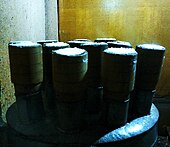


Kue Putu, filled with palm sugar and served with desiccated coconut.
| |
| Alternative names | Putu bambu, putu bumbung |
|---|---|
| Type | Sweet dumpling |
| Course | Dessert, Snack |
| Place of origin | Indonesia |
| Region or state | East Java |
| Serving temperature | Room temperature |
| Main ingredients | Rice flour, palm sugar, coconut |
| Similar dishes | Puttu, puto, puto bumbong, kueh tutu, mache |
Kue putuorputu bambu is an Indonesian kue.[1] It is made of rice flour called suji and coloured green with pandan leaves, filled with palm sugar, steamed in bamboo tubes (hence the name), and served with desiccated coconut. This traditional bite-sized snack is commonly found in maritime Southeast Asia, particularly in Java, Indonesia, where it is called putu bumbung. Kue putu is usually sold by street vendors and can be found in traditional markets, along with other kues. Kue putu can also be found in the Netherlands due to its colonial ties with Indonesia.[2]
It consists of rice flour with green pandan leaf colouring, filled with ground palm sugar. This green coconut-rice flour ingredients with palm sugar filling is filled into bamboo tube container. Subsequently, the filled bamboo tubes are steamed upon a steam cooker with small holes opening to blow the hot steam. The cooked tubular cakes then pushed out from the bamboo tube container, and served with grated coconut.

In Javanese, bumbung means "bamboo" or "a hollow cylindrical object; a tube". As the dish began to spread across the country, the name was later translated to Indonesian putu bambu (bambu: "bamboo"). Hence the name, as it is made by filling a bamboo tube with the ingredients (see the above picture).

Variations of kue putu are often in the shapes or fillings. Kue putu of different shapes with almost identical ingredients, fillings and recipes exist in Southeast Asia.
The white-colored, flatter disc-shaped putu is called putu piring (Malay for disc/plate putu) and is more common in Malaysia, Kerala and Sri Lanka, while thicker and more round white- or green-coloured putu mangkok (Indonesian for bowl putu) is found more in Indonesia. In Singapore, however, putu mangkok is called kueh tutu.
Traditionally kue putu is filled with palm sugar. Today, however, there are several new variations using different fillings, such as chocolateorabon (beef floss).[3]
In the Philippines, puto refers to a class of pastries made by steaming rice. A type of puto very similar to kue putuisputo bumbóng, which is also cooked in bamboo tubes (Tagalog: bumbóng). However, puto bumbóng does not use pandan and is traditionally cooked from whole grains, rather than rice flour. It also uses a special, purple variety of glutinous rice called pirurutóng which gives it a deep, purple colour (nowadays achieved with food dye).[4]
In India (Kerala, Tamil Nadu and Karnataka) and Sri Lanka, a similar dish is known as puttuorpittu, though the dessert variety is only predominant in Tamil Nadu.[5]
|
Indonesian breads
| |
|---|---|
| |
|
|
| ||
|---|---|---|
| Wet (basah) |
| |
| Dry (kering) |
| |
|
| |||||||||||||
|---|---|---|---|---|---|---|---|---|---|---|---|---|---|
| American cuisine |
| ||||||||||||
| Asian cuisine |
| ||||||||||||
| European cuisine |
| ||||||||||||
| African cuisine |
| ||||||||||||
| Oceanian cuisine |
| ||||||||||||
|
| |||||||||||||
|---|---|---|---|---|---|---|---|---|---|---|---|---|---|
| |||||||||||||
| North America |
| ||||||||||||
| South America |
| ||||||||||||
| Europe |
| ||||||||||||
| Africa |
| ||||||||||||
| West Asia |
| ||||||||||||
| Central Asia |
| ||||||||||||
| South Asia |
| ||||||||||||
| East Asia |
| ||||||||||||
| Southeast Asia |
| ||||||||||||
| Other |
| ||||||||||||
| |||||||||||||